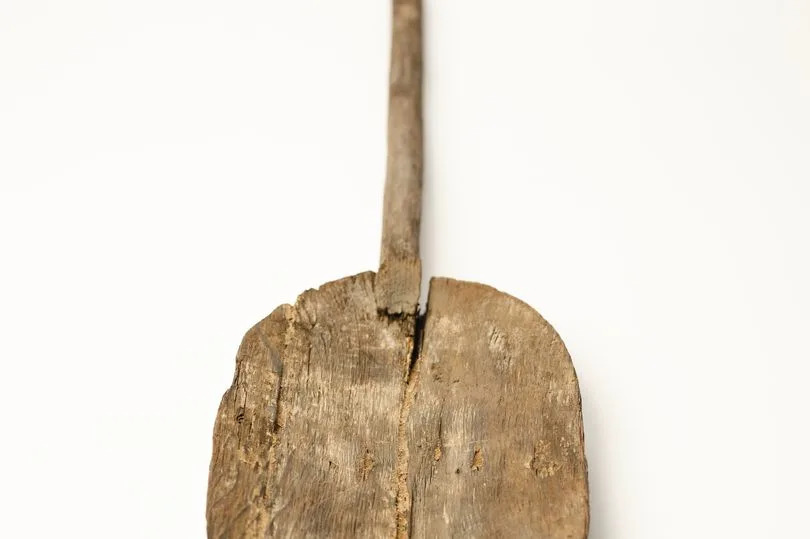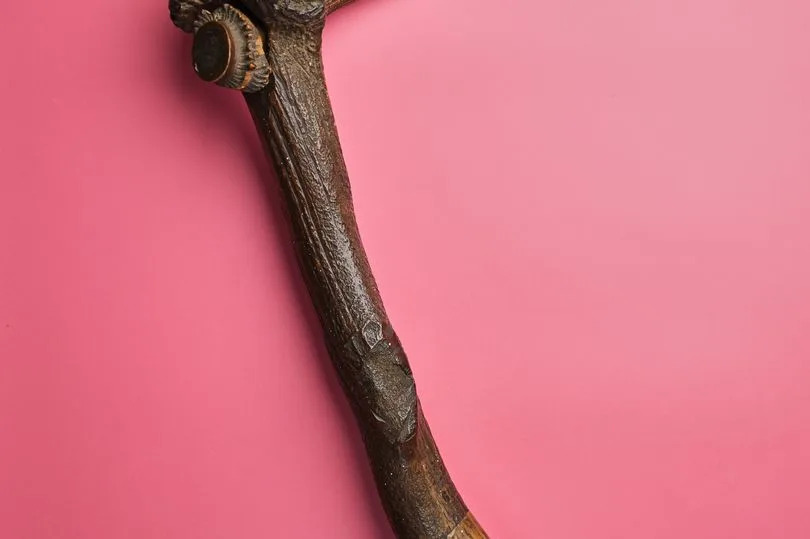Kate Lockett
Fri, 14 June 2024

Royal Cornwall Museum has revealed the existence of the oldest Bronze Age mining tools ever found in Europe The oak wooden shovel is said to be around 3,200 years old (Image: Royal Cornwall Museum)
In an exciting discovery, the Royal Cornwall Museum has revealed the existence of the oldest Bronze Age mining tools ever found in Europe.
The findings which date back more than 3,600 years ago, have been revealed ahead of the museum’s redesigned Mineral Gallery set to open in July 2024. The gallery will show the current understanding of prehistoric mining practices and highlight how Cornwall played a significant role in the early stages of European metalworking.
Recent carbon dating research on an Oak Shovel along with evidence from examination of an Antler Pick has signified that these two items within the museum’s archive are the first Bronze Age tin mining tools to be found in Europe.
The tools were discovered in the Carnon Valley, mid-Cornwall during the 19th century when alluvial tin stream works were being reworked in the 19th century. Alluvial time stream works is a shallow mining operation following streams with naturally occurring deposits of tin. The radiocarbon dating indicated that they were from the British Bronze Age (2400-800BC).
Led by Dr Alan Williams from the Department of Archaeology at Durham University, the Royal Cornwall Museum’s oak wooden shovel has most recently been radiocarbon dated at around 3,200 years old by the Project Ancient Tin Team, with a grant from the Royal Archaeological Institute.
Understood to be found in the Caron Valley in 1815, this design is formed from one piece of wood, unlike Medieval wooden shovels that are in two pieces.

The Oak Shovel is set to go on display at the Royal Cornwall Museum -Credit:Royal Cornwall Museum

The Royal Cornwall Museum has unveiled the Antler Pick -Credit:Royal Cornwall Museum
The antler pick, measuring 48cm in length is estimated to be around 3,600 years old, or Early Bronze Age is the first evidence for the extraction of tin and/ or alluvial gold in the British Isles. Following examination of the tool by Dr Simon Timberlake from the Early Mines Research Group it was revealed that tally marks had been carved into the antler pick suggesting a system of recording work by prehistoric miners.
These discoveries provide crucial evidence of Bronze Age tin workings in Cornwall, demonstrating the mining techniques at this early stage. They also support the growing theory that Cornwall was a primary source of tin for the European Bronze Age.
Adding further weight to this theory, small amounts of gold found in the Carnon Valley have been chemically linked to the gold used in the famous Nebra Sky Disk, an artefact thought to be the world’s oldest map of the stars. The presence of Cornish gold and tin in this artefact discovered in Germany, suggests that Cornish prehistoric mining and trading practices may have pioneered the European Bronze Age.
The new Mineral Gallery will be a chance to celebrate the past and future of Cornish mining (Image: Royal Cornwall Museum)
Bryony Robins, artistic director for the Royal Cornwall Museum said: “Cornwall and mining are already intertwined, but this important discovery demonstrates just how long mining has been taking place in Cornwall, and how well developed some of the tools of the trade were, even at that time.
“The Mineral Gallery will share with our visitors the heritage of mining in Cornwall and present the world-renowned collection of rocks and minerals in a more accessible way. And, of course, the role that mining is continuing to play in Cornwall.”
Reopening in early July 2024, the new Mineral Gallery will be a chance to celebrate the past and future of Cornish mining, with the unveiling of this first phase of the museum’s transformation which continues into 2025.
This is just the start of an exciting new era for this 200-year-old institution - a centre of exploration, learning, and custodian of Cornish heritage - home to over one million artefacts.
‘The significance of the boom and bust of Bronze Age mining in Wales for Scandinavia, England and Atlantic Europe’
14 June 2024
The University of Wales Centre for Advanced Welsh and Celtic Studies (CAWCS) held an international conference on 3–6 June 2024 that looked at Bronze Age mining and metals and the long-distance contacts between Scandinavia, Wales and beyond.
The conference also helped build new frameworks for exploring implications of Bronze Age trade for maritime transport, migration, social change, and contact between prehistoric languages.
Recent chemical and isotopic analysis in Nordic Bronze Age tools and weapons indicates that important sources of their metal were ancient copper mines near Aberystwyth in mid Wales from 2100–1700 BC and Great Orme in north Wales from 1700–1400 BC.
Two days of talks and panel discussions were held at CAWCS and the adjacent National Library of Wales. Speakers included experts from Wales, England, Spain, Brittany, Scandinavia, and America. A day-long site visit took participants to Beaker Period and Early Bronze Age (2200–1700 BC) copper mines in Cwmystwyth with the leading expert on the sites (Dr Simon Timberlake, Cambridge). The mining tools found at these sites included many stone hammers worked from large sea-rounded pebbles, brought up the valley from the coast, where Aberystwyth now sits at a natural harbour, below the prehistoric hillfort of Pendinas, with its long views along the coast and up the Ystwyth valley towards the mines. A second day-long site visit took participants to the Middle Bronze Age (1700–1400 BC) mine at Great Orme with the leading expert on the site (Dr Alan Williams, Liverpool and Durham).
The conference set up specific networks and initiatives to investigate implications of the ‘boom and bust’ of Wales’s Bronze Age copper mines and looked at the place of mining, metals and long-distance exchange in greater Bronze Age processes—cultures, populations, and languages.
Conference organiser, Professor John T. Koch from CAWCS, said: ‘There is such a wide awareness in Wales of the importance of mining for modern social, economic, and political history. It has affected so many people, in their family background and in shaping the places they live in a wide variety of ways. When you explain that mining in, and mining exports from, Wales go back 4,000 years, that’s startling news. It sparks an immediate interest beyond the usual audience for specialist research’.
Professor Elin Haf Gruffydd Jones, Director of CAWCS, said: ‘We’re delighted that the conference is being hosted here in Wales, at the University of Wales Centre for Advanced Welsh and Celtic Studies, at the National Library of Wales and at the site-specific locations that are of such significance to the research field. I’d like to congratulate the project lead Professor Johan Ling at Gothenburg University and Professor John T. Koch on the curation of the conference and also thank Sweden’s central bank for their support of the research project on ‘Maritime Encounters’.’
The conference builds on a wider 6-year multidisciplinary research programme called ‘Maritime Encounters: a counterpoint to the dominant terrestrial narrative of European prehistory’. The project includes 17 specialists from archaeology, historical linguistics, genetics, oceanography, and anthropology based in 8 countries. The project aims to create a more detailed and nuanced story of how prehistoric societies realised major and minor sea crossings, organised long-distance exchange, and ways of life by the sea in prehistory. For more information see: https://www.gu.se/en/research/maritime-encounters
Notes for Editors
Contact: Dr Angharad Elias (Admin Officer) a.elias@wales.ac.uk
1. The Centre for Advanced Welsh and Celtic Studies (CAWCS) was established by the University of Wales in 1985 as a dedicated research centre conducting team-based projects on the languages, literatures, culture and history of Wales and the other Celtic countries. It is located in Aberystwyth, adjacent to the National Library of Wales, which is an internationally renowned copyright library with excellent research facilities.
2. CAWCS offers unique opportunities for postgraduate students to work alongside specialists in a dynamic and supportive environment. We welcome enquiries about MPhil/PhD topics in any of our research areas. For more information about research opportunities, or for an informal chat about possible topics, contact our Head of Graduate Studies, Dr Elizabeth Edwards: e.edwards@wales.ac.uk
3. CAWCS is the home of the Dictionary of the Welsh Language, which celebrated its centenary in 2021: https://www.welsh-dictionary.ac.uk/






No comments:
Post a Comment